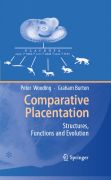
Comparative placentation: structures, functions and evolution
Wooding, P.
Burton, G.
The reasons for the range of placental structures and their evolution presents a fascinating scientific puzzle . It is also of immediate medical relevance since in man and animals impaired placental growth has recently been shown to be associated with an increased incidence of cardiovascular , metabolic and other diseases in later life [see The Fetal Matrix , Gluckman and Hanson , CUP ,2005 ] Comparative placental studies will facilitate an understanding of whatfactors control this impaired growth in humans and also allow informed selection of valid animal models. The most important feature of the book will be theunique collection of the best Light and Electron micrographs [all with full authorisation to use ]from the last 35 years which precisely illustrate the structural range in each vertebrate taxon. These are reinforced by a series of line diagrams clarifying the developmental origin and detail of the functional placental units. INDICE: 1. Placentation fundamentals.- 2. Implantation, Maternofetal exchange and Vascular relationships.- 3. Fish, Amphibia, Bird and Reptile placentation.- 4. Monotreme and Marsupial placentation.- 5. Eutherian Epitheliochorial placentation, Pig and Horse.- 6. Synepitheliochorial placentation, Ruminants, Ewe and Cow.- 7. Endotheliochorial placentation, Cat, Dog.- 8. Haemochorial placentation, Mouse, Rabbit and Human.- 9. Immunology, Viviparity and Evolution.- 10. Hybridisation, Cloning and Fetal Origins of Adult Disease.
- ISBN: 978-3-540-78796-9
- Editorial: Springer
- Encuadernacion: Cartoné
- Páginas: 310
- Fecha Publicación: 01/06/2008
- Nº Volúmenes: 1
- Idioma: Inglés
